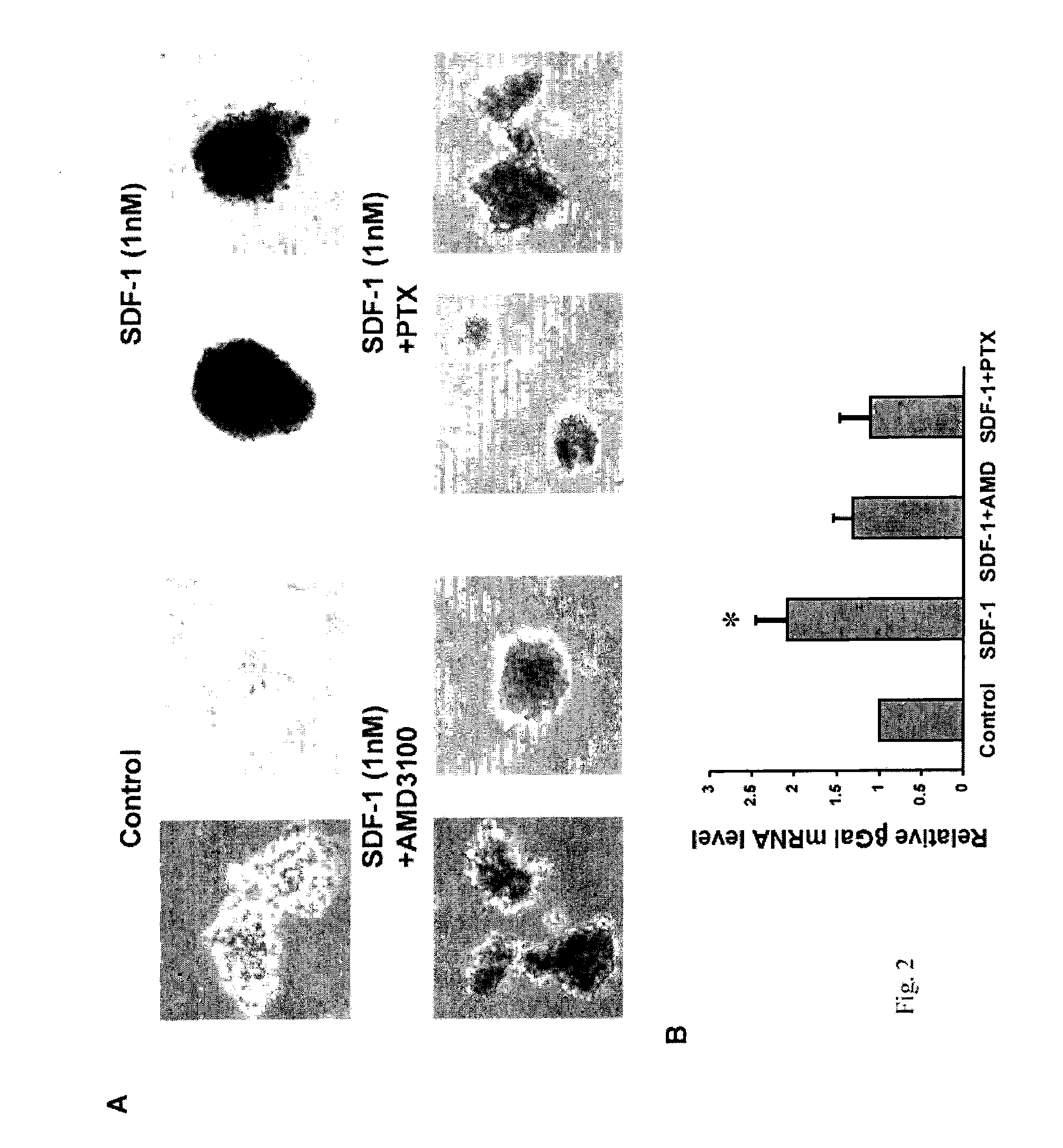Therapeutic method for increasing pancreatic beta cell mass
a technology for pancreatic beta cells and therapeutic methods, applied in the field of diabetes treatment, can solve the problems of inability to express beta cells, functional impairment, and diabetes mellitus, and achieve the effects of increasing the mass of beta cells, increasing the beta cell survival rate, and increasing the beta cell mass
- Summary
- Abstract
- Description
- Claims
- Application Information
AI Technical Summary
Benefits of technology
Problems solved by technology
Method used
Image
Examples
example 1
Materials and Methods
[0081]Isolated mouse pancreatic islets Mouse islets were isolated (Lacy PE (1994) Pancreatic islet cell transplant. Mt Sinai J. Med. 61:23-31.) from the pancreata of TopGal reporter mice transgenic for the LEF-LacZ Wnt signaling reporter (DasGupta R, Fuchs E (1999) Development. 1999 126:4557-4568.). Freshly isolated islets were treated for 4 hrs with SDF-1 with and without the addition of the Galphai / o inhibitor pertussis toxin (PTX) or the CXCR4 antagonist AMD3100. Betagalactosidase activity was determined by incubation of the islets with X-gal for 6 hrs. All mouse studies were approved by and in compliance with the MGH IACUC.
[0082]Polymerase chain reaction analyses of betagalactosidase mRNA levels in isolated mouse islets Islets from TopGal mice were harvested after treatments with SDF-1, SDF-1+AMD3100, and SDF-1+pertussis toxin. RNA was extracted and beta galactosidase mRNA levels were measured by PCR using a SYBR Green QPCR kit (Stratagene) with the primers ...
example 2
SDF-1 / CXCR4 Axis Activates Wnt Signaling in Isolated Mouse Islets
[0094]Earlier we reported the expression of SDF-1 in MIN6 beta cells and in the peri-islet stromal tissue and intra-islet endothelial tissue of adult mouse pancreas, as well as expression of the SDF-1 receptor, CXCR4, on both mouse islet beta cells and the MIN6 and INS-1 clonal beta cell lines. Since SDF-1 was recently reported to activate the Wnt signaling pathway in rat neural progenitor cells, we determined whether SDF-1 activates Wnt signaling in pancreatic beta cells. We used isolated islets prepared from the pancreas of the TopGal Wnt signaling reporter mouse in which the expression of beta-galactosidase activity (dark region) indicates activation of the downstream Wnt signaling pathway. Addition of SDF-1 (1 nM) to isolated TopGal islets turned them dark (FIG. 2A). Since the majority of cells (>80%) in islets are beta cells, we conclude that SDF-1 activates Wnt signaling in beta cells. The specificity of the inte...
example 3
SDF-1 Activates Wnt Signaling in INS-1 Cells Via the SDF-1 Receptor
[0095]To investigate the mechanisms by which SDF-1 / CXCR4 activates Wnt signaling in beta cells we undertook studies in INS-1 cells, a differentiated clonal beta cell line. We examined SDF-1 induction of Wnt signaling using a Wnt signaling reporter assay (TOPflash / FOPflash). The TOPflash and FOPflash constructs contain the luciferase reporter either under the control of consensus TCF7L2-binding sites or mutated TCF7L2-binding sites, respectively. Luciferase activity was measured during 4 hr after addition of 1 nM SDF-1 (FIG. 3A). SDF-1 activated Wnt signaling dosedependently with maximum responses achieved at 0.4 nM (FIG. 3B). SDF-1 activation of luciferase activity was antagonized by coincubation with increasing amounts of the CXCR4 antagonist AMD3100 (FIG. 3C), indicating that the activation of Wnt signaling by SDF-1 occurs via the SDF-1 receptor.
PUM
| Property | Measurement | Unit |
|---|---|---|
| Mass | aaaaa | aaaaa |
| Cell proliferation rate | aaaaa | aaaaa |
Abstract
Description
Claims
Application Information
 Login to View More
Login to View More - R&D
- Intellectual Property
- Life Sciences
- Materials
- Tech Scout
- Unparalleled Data Quality
- Higher Quality Content
- 60% Fewer Hallucinations
Browse by: Latest US Patents, China's latest patents, Technical Efficacy Thesaurus, Application Domain, Technology Topic, Popular Technical Reports.
© 2025 PatSnap. All rights reserved.Legal|Privacy policy|Modern Slavery Act Transparency Statement|Sitemap|About US| Contact US: help@patsnap.com



